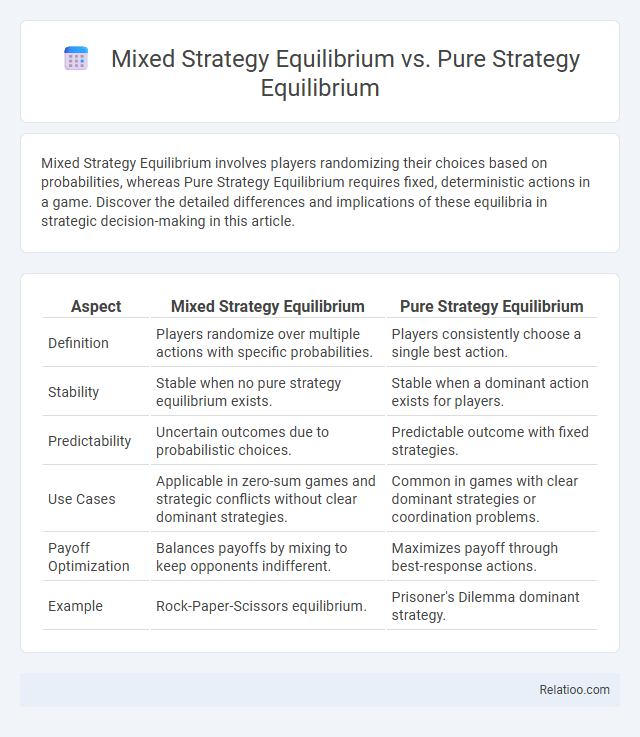Mixed Strategy Equilibrium involves players randomizing their choices based on probabilities, whereas Pure Strategy Equilibrium requires fixed, deterministic actions in a game. Discover the detailed differences and implications of these equilibria in strategic decision-making in this article.
Table of Comparison
| Aspect | Mixed Strategy Equilibrium | Pure Strategy Equilibrium |
|---|---|---|
| Definition | Players randomize over multiple actions with specific probabilities. | Players consistently choose a single best action. |
| Stability | Stable when no pure strategy equilibrium exists. | Stable when a dominant action exists for players. |
| Predictability | Uncertain outcomes due to probabilistic choices. | Predictable outcome with fixed strategies. |
| Use Cases | Applicable in zero-sum games and strategic conflicts without clear dominant strategies. | Common in games with clear dominant strategies or coordination problems. |
| Payoff Optimization | Balances payoffs by mixing to keep opponents indifferent. | Maximizes payoff through best-response actions. |
| Example | Rock-Paper-Scissors equilibrium. | Prisoner's Dilemma dominant strategy. |
Introduction to Game Theory Equilibriums
Game theory equilibriums analyze players' optimal strategies in interactive decision-making scenarios, with Pure Strategy Equilibrium representing situations where each player consistently chooses a single best action. Mixed Strategy Equilibrium allows players to randomize over multiple actions, assigning probabilities to strategies when no pure strategy strictly dominates. Understanding these equilibria helps predict stable outcomes in competitive environments, revealing how rational players balance their choices to maximize payoffs.
Defining Pure Strategy Equilibrium
Pure Strategy Equilibrium occurs when players consistently choose a single, specific action, maximizing their payoffs given the other players' strategies. In contrast, Mixed Strategy Equilibrium involves players randomizing over possible actions with fixed probabilities, making opponents indifferent between their choices. Both concepts fall under the broader framework of Nash Equilibrium, where no player gains by unilaterally changing their strategy.
Defining Mixed Strategy Equilibrium
Mixed Strategy Equilibrium occurs when players in a game randomize over possible moves to maximize their outcomes, differing from Pure Strategy Equilibrium where players choose a single decisive action. In contrast, a general Equilibrium encompasses any stable strategy profile, including both mixed and pure strategies, that no player can improve unilaterally. Your understanding of Mixed Strategy Equilibrium is crucial for analyzing situations where no pure strategy dominates, leading to probabilistic behavior in strategic decision-making.
Key Differences Between Pure and Mixed Strategies
Pure Strategy Equilibrium involves players consistently choosing a single action, while Mixed Strategy Equilibrium requires players to randomize over multiple actions with specific probabilities to keep opponents indifferent. The key difference lies in predictability: pure strategies yield deterministic outcomes, whereas mixed strategies introduce probabilistic decision-making to handle strategic uncertainty. Mixed strategies are critical in games lacking pure equilibrium by ensuring the existence of at least one equilibrium through probability distributions over possible moves.
Examples Illustrating Pure Strategy Equilibrium
Pure Strategy Equilibrium occurs when players choose a single best strategy with complete certainty, such as in the classic Prisoner's Dilemma where both players defect to minimize loss. In contrast, Mixed Strategy Equilibrium involves players randomizing over strategies to keep opponents indifferent, as seen in Rock-Paper-Scissors, where no pure strategy dominates. Understanding these distinctions helps you analyze strategic interactions effectively by identifying stable outcomes in different game scenarios.
Examples Illustrating Mixed Strategy Equilibrium
Mixed strategy equilibrium occurs when players randomize their choices to keep opponents indifferent, unlike pure strategy equilibrium where players choose a single best response. In the classic Rock-Paper-Scissors game, no pure strategy equilibrium exists, but the mixed strategy equilibrium involves each player choosing rock, paper, or scissors with equal probability of one-third. Another example is in penalty kicks in soccer, where the kicker and goalkeeper randomize their actions to avoid predictability, embodying mixed strategy equilibria.
Real-World Applications of Pure Strategies
Pure Strategy Equilibrium occurs when players consistently choose one specific action, contrasting with Mixed Strategy Equilibrium where players randomize between strategies to keep opponents uncertain. In real-world applications, Pure Strategies often manifest in competitive markets where firms settle on stable pricing or production levels, such as airlines fixing fares on popular routes or sports teams adopting a consistent game plan. Your understanding of Pure Strategy Equilibrium can help predict and analyze scenarios where decisions are clear-cut and predictable rather than probabilistic.
Real-World Applications of Mixed Strategies
Mixed Strategy Equilibrium involves players randomizing their choices to keep opponents uncertain, enabling more flexible and unpredictable decision-making compared to Pure Strategy Equilibrium, where players consistently choose one specific action. Real-world applications of mixed strategies can be seen in competitive sports, cybersecurity defenses, and pricing strategies in markets where unpredictability can provide a strategic advantage. Your ability to understand and apply mixed strategies can enhance strategic planning in negotiations, auctions, and conflict resolution scenarios where no single pure strategy guarantees success.
Advantages and Limitations of Each Approach
Mixed strategy equilibrium allows players to randomize their actions, providing strategic unpredictability that can solve games lacking pure strategy equilibria, yet it may be complex to compute and interpret. Pure strategy equilibrium offers straightforward, stable predictions where players choose a single best response, but it may not exist in all games or fail to capture real-world strategic variability. General equilibrium concepts unify multiple agents' strategies across markets or games, fostering comprehensive analysis but often assume conditions like perfect rationality and complete information, limiting practical applicability.
When to Use Pure vs Mixed Strategy Equilibriums
Pure strategy equilibrium is ideal when players have a clear best response with no incentives to randomize, often seen in games with dominant strategies. Mixed strategy equilibrium applies when players are indifferent among multiple actions, enabling you to randomize and keep opponents uncertain. Choosing between pure and mixed strategy equilibrium depends on whether your game scenario involves strict preferences or necessitates strategic unpredictability to prevent exploitation.

Infographic: Mixed Strategy Equilibrium vs Pure Strategy Equilibrium
 relatioo.com
relatioo.com